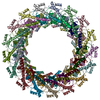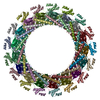[English] 日本語
 Yorodumi
Yorodumi- EMDB-22077: Cryo-EM Structure of CagX and CagY within the dCag3 Helicobacter ... -
+ Open data
Open data
- Basic information
Basic information
| Entry | Database: EMDB / ID: EMD-22077 | ||||||||||||||||||||||||
|---|---|---|---|---|---|---|---|---|---|---|---|---|---|---|---|---|---|---|---|---|---|---|---|---|---|
| Title | Cryo-EM Structure of CagX and CagY within the dCag3 Helicobacter pylori PR | ||||||||||||||||||||||||
 Map data Map data | Helicobacter pylori T4SS dCag3 PR | ||||||||||||||||||||||||
 Sample Sample |
| ||||||||||||||||||||||||
| Function / homology |  Function and homology information Function and homology information | ||||||||||||||||||||||||
| Biological species |   Helicobacter pylori (bacteria) / Helicobacter pylori (bacteria) /   Helicobacter pylori (strain ATCC 700392 / 26695) (bacteria) Helicobacter pylori (strain ATCC 700392 / 26695) (bacteria) | ||||||||||||||||||||||||
| Method |  single particle reconstruction / single particle reconstruction /  cryo EM / Resolution: 3.0 Å cryo EM / Resolution: 3.0 Å | ||||||||||||||||||||||||
 Authors Authors | Sheedlo MJ / Chung JM / Sawhney N / Durie CL / Cover TL / Ohi MD / Lacy DB | ||||||||||||||||||||||||
| Funding support |  United States, 7 items United States, 7 items
| ||||||||||||||||||||||||
 Citation Citation |  Journal: Elife / Year: 2020 Journal: Elife / Year: 2020Title: Cryo-EM reveals species-specific components within the Cag type IV secretion system core complex. Authors: Michael J Sheedlo / Jeong Min Chung / Neha Sawhney / Clarissa L Durie / Timothy L Cover / Melanie D Ohi / D Borden Lacy /  Abstract: The pathogenesis of -associated gastric cancer is dependent on delivery of CagA into host cells through a type IV secretion system (T4SS). The Cag T4SS includes a large membrane-spanning core ...The pathogenesis of -associated gastric cancer is dependent on delivery of CagA into host cells through a type IV secretion system (T4SS). The Cag T4SS includes a large membrane-spanning core complex containing five proteins, organized into an outer membrane cap (OMC), a periplasmic ring (PR) and a stalk. Here, we report cryo-EM reconstructions of a core complex lacking Cag3 and an improved map of the wild-type complex. We define the structures of two unique species-specific components (Cag3 and CagM) and show that Cag3 is structurally similar to CagT. Unexpectedly, components of the OMC are organized in a 1:1:2:2:5 molar ratio (CagY:CagX:CagT:CagM:Cag3). CagX and CagY are components of both the OMC and the PR and bridge the symmetry mismatch between these regions. These results reveal that assembly of the T4SS core complex is dependent on incorporation of interwoven species-specific components. | ||||||||||||||||||||||||
| History |
|
- Structure visualization
Structure visualization
| Movie |
 Movie viewer Movie viewer |
|---|---|
| Structure viewer | EM map:  SurfView SurfView Molmil Molmil Jmol/JSmol Jmol/JSmol |
| Supplemental images |
- Downloads & links
Downloads & links
-EMDB archive
| Map data |  emd_22077.map.gz emd_22077.map.gz | 473.4 MB |  EMDB map data format EMDB map data format | |
|---|---|---|---|---|
| Header (meta data) |  emd-22077-v30.xml emd-22077-v30.xml emd-22077.xml emd-22077.xml | 13.6 KB 13.6 KB | Display Display |  EMDB header EMDB header |
| FSC (resolution estimation) |  emd_22077_fsc.xml emd_22077_fsc.xml | 18 KB | Display |  FSC data file FSC data file |
| Images |  emd_22077.png emd_22077.png | 100.3 KB | ||
| Archive directory |  http://ftp.pdbj.org/pub/emdb/structures/EMD-22077 http://ftp.pdbj.org/pub/emdb/structures/EMD-22077 ftp://ftp.pdbj.org/pub/emdb/structures/EMD-22077 ftp://ftp.pdbj.org/pub/emdb/structures/EMD-22077 | HTTPS FTP |
-Related structure data
| Related structure data |  6x6lMC  6x6jC  6x6kC  6x6sC M: atomic model generated by this map C: citing same article ( |
|---|---|
| Similar structure data |
- Links
Links
| EMDB pages |  EMDB (EBI/PDBe) / EMDB (EBI/PDBe) /  EMDataResource EMDataResource |
|---|
- Map
Map
| File |  Download / File: emd_22077.map.gz / Format: CCP4 / Size: 506 MB / Type: IMAGE STORED AS FLOATING POINT NUMBER (4 BYTES) Download / File: emd_22077.map.gz / Format: CCP4 / Size: 506 MB / Type: IMAGE STORED AS FLOATING POINT NUMBER (4 BYTES) | ||||||||||||||||||||||||||||||||||||||||||||||||||||||||||||||||||||
|---|---|---|---|---|---|---|---|---|---|---|---|---|---|---|---|---|---|---|---|---|---|---|---|---|---|---|---|---|---|---|---|---|---|---|---|---|---|---|---|---|---|---|---|---|---|---|---|---|---|---|---|---|---|---|---|---|---|---|---|---|---|---|---|---|---|---|---|---|---|
| Annotation | Helicobacter pylori T4SS dCag3 PR | ||||||||||||||||||||||||||||||||||||||||||||||||||||||||||||||||||||
| Voxel size | X=Y=Z: 1 Å | ||||||||||||||||||||||||||||||||||||||||||||||||||||||||||||||||||||
| Density |
| ||||||||||||||||||||||||||||||||||||||||||||||||||||||||||||||||||||
| Symmetry | Space group: 1 | ||||||||||||||||||||||||||||||||||||||||||||||||||||||||||||||||||||
| Details | EMDB XML:
CCP4 map header:
| ||||||||||||||||||||||||||||||||||||||||||||||||||||||||||||||||||||
-Supplemental data
- Sample components
Sample components
-Entire : Helicobacter pylori dCag3 Cag T4SS PR
| Entire | Name: Helicobacter pylori dCag3 Cag T4SS PR |
|---|---|
| Components |
|
-Supramolecule #1: Helicobacter pylori dCag3 Cag T4SS PR
| Supramolecule | Name: Helicobacter pylori dCag3 Cag T4SS PR / type: complex / ID: 1 / Parent: 0 / Macromolecule list: all |
|---|---|
| Source (natural) | Organism:   Helicobacter pylori (bacteria) Helicobacter pylori (bacteria) |
-Macromolecule #1: Cag pathogenicity island protein (Cag8)
| Macromolecule | Name: Cag pathogenicity island protein (Cag8) / type: protein_or_peptide / ID: 1 / Number of copies: 17 / Enantiomer: LEVO |
|---|---|
| Source (natural) | Organism:   Helicobacter pylori (strain ATCC 700392 / 26695) (bacteria) Helicobacter pylori (strain ATCC 700392 / 26695) (bacteria)Strain: ATCC 700392 / 26695 |
| Molecular weight | Theoretical: 60.607324 KDa |
| Sequence | String: MGQAFFKKIV GCFCLGYLFL SSAIEAAALD IKNFNRGRVK VVNKKIAYLG DEKPITIWTS LDNVTVIQLE KDETISYITT GFNKGWSIV PNSNHIFIQP KSVKSNLMFE KEAVNFALMT RDYQEFLKTK KLIVDAPDPK ELEEQKKALE KEKEAKEQAQ K AQKDKREK ...String: MGQAFFKKIV GCFCLGYLFL SSAIEAAALD IKNFNRGRVK VVNKKIAYLG DEKPITIWTS LDNVTVIQLE KDETISYITT GFNKGWSIV PNSNHIFIQP KSVKSNLMFE KEAVNFALMT RDYQEFLKTK KLIVDAPDPK ELEEQKKALE KEKEAKEQAQ K AQKDKREK RKEERAKNRA NLENLTNAMS NPQNLSNNKN LSEFIKQQRE NELDQMERLE DMQEQAQANA LKQIEELNKK QA EETIKQR AKDKINIKTD KPQKSPEDNS IELSPSDSAW RTNLVVRTNK ALYQFILRIA QKDNFASAYL TVKLEYPQRH EVS SVIEEL KKREEAKRQK ELIKQENLNT TAYINRVMMA SNEQIINKEK IREEKQKIIL DQAKALETQY VHNALKRNPV PRNY NYYQA PEKRSKHIMP SEIFDDGTFT YFGFKNITLQ PAIFVVQPDG KLSMTDAAID PNMTNSGLRW YRVNEIAEKF KLIKD KALV TVINKGYGKN PLTKNYNIKN YGELERVIKK LPEVRDK |
-Macromolecule #2: Cag pathogenicity island protein (Cag7)
| Macromolecule | Name: Cag pathogenicity island protein (Cag7) / type: protein_or_peptide / ID: 2 / Number of copies: 17 / Enantiomer: LEVO |
|---|---|
| Source (natural) | Organism:   Helicobacter pylori (strain ATCC 700392 / 26695) (bacteria) Helicobacter pylori (strain ATCC 700392 / 26695) (bacteria)Strain: ATCC 700392 / 26695 |
| Molecular weight | Theoretical: 219.748641 KDa |
| Sequence | String: MNEENDKLET SKKAQQDSPQ DLSNEEATEA NHFENLLKES KESSDHHLDN PTETQTHFDG DKSEETQTQM DSEGNETSES SNGSLADKL FKKARKLVDN KKPFTQQKNL DEETQELNEE DDQENNEYQE ETQTDLIDDE TSKKTQQHSP QDLSNEEATE A NHFENLLK ...String: MNEENDKLET SKKAQQDSPQ DLSNEEATEA NHFENLLKES KESSDHHLDN PTETQTHFDG DKSEETQTQM DSEGNETSES SNGSLADKL FKKARKLVDN KKPFTQQKNL DEETQELNEE DDQENNEYQE ETQTDLIDDE TSKKTQQHSP QDLSNEEATE A NHFENLLK ESKESSDHHL DNPTETQTNF DGDKSEETQT QMDSEGNETS ESSNGSLADK LFKKARKLVD NKKPFTQQKN LD EETQELN EEDDQENNEY QEETQTDLID DETSKKTQQH SPQDLSNEEA TEANHFENLL KESKESSDHH LDNPTETQTN FDG DKSEEI TDDSNDQEII KGSKKKYIIG GIVVAVLIVI ILFSRSIFHY FMPLEDKSSR FSKDRNLYVN DEIQIRQEYN RLLK ERNEK GNMIDKNLFF NDDPNRTLYN YLNIAEIEDK NPLRAFYECI SNGGNYEECL KLIKDKKLQD QMKKTLEAYN DCIKN AKTE EERIKCLDLI KDENLKKSLL NQQKVQVALD CLKNAKTDEE RNECLKLIND PEIREKFRKE LELQKELQEY KDCIKN AKT EAEKNKCLKG LSKEAIERLK QQALDCLKNA KTDEERNECL KNIPQDLQKE LLADMSVKAY KDCVSKARNE KEKQECE KL LTPEARKKLE QQVLDCLKNA KTDEERKKCL KDLPKDLQSD ILAKESLKAY KDCVSQAKTE AEKKECEKLL TPEAKKLL E EEAKESVKAY LDCVSQAKTE AEKKECEKLL TPEAKKKLEE AKKSVKAYLD CVSRARNEKE KKECEKLLTP EAKKLLEQQ ALDCLKNAKT DKERKKCLKD LPKDLQKKVL AKESVKAYLD CVSQAKTEAE KKECEKLLTP EARKLLEEAK KSVKAYLDCV SQAKTEAEK KECEKLLTPE ARKLLEE(UNK)AK ESVKAYLDCV SQAKNEAEKK ECEKLLTLES KKKLEEAKKS VKAYLDC VS QAKTEAEKKE CEKLLTPEAK KLLEQQALDC LKNAKTEADK KRCVKDLPKD LQKKVLAKES LKAYKDCVSK ARNEKEKK E CEKLLTPEAK KLLEEAKKSV KAYLDCVSQA KTEAEKKECE KLLTPEARKL LEEAKESVKA YKDCVSKARN EKEKKECEK LLTPEAKKLL EQQVLDCLKN AKTEADKKRC VKDLPKDLQK KVLAKESVKA YLDCVSRARN EKEKKECEKL LTPEAKKLLE EAKESLKAY KDCLSQARNE EERRACEKLL TPEARKLLEQ EVKKSIKAYL DCVSRARNEK EKKECEKLLT PEARKFLAKQ V LNCLEKAG NEEERKACLK NLPKDLQENI LAKESLKAYK DCLSQARNEE ERRACEKLLT PEARKLLEQE VKKSVKAYLD CV SRARNEK EKKECEKLLT PEARKFLAKE LQQKDKAIKD CLKNADPNDR AAIMKCLDGL SDEEKLKYLQ EAREKAVADC LAM AKTDEE KRKCQNLYSD LIQEIQNKRT QNKQNQLSKT ERLHQASECL DNLDDPTDQE AIEQCLEGLS DSERALILGI KRQA DEVDL IYSDLRNRKT FDNMAAKGYP LLPMDFKNGG DIATINATNV DADKIASDNP IYASIEPDIA KQYETEKTIK DKNLE AKLA KALGGNKKDD DKEKSKKSTA EAKAENNKID KDVAETAKNI SEIALKNKKE KSGEFVDENG NPIDDKKKAE KQDETS PVK QAFIGKSDPT FVLAQYTPIE ITLTSKVDAT LTGIVSGVVA KDVWNMNGTM ILLDKGTKVY GNYQSVKGGT PIMTRLM IV FTKAITPDGV IIPLANAQAA GMLGEAGVDG YVNNHFMKRI GFAVIASVVN SFLQTAPIIA LDKLIGLGKG RSERTPEF N YALGQAINGS MQSSAQMSNQ ILGQLMNIPP SFYKNEGDSI KILTMDDIDF SGVYDVKITN KSVVDEIIKQ STKTLSREH EEITTSPKGG N |
-Experimental details
-Structure determination
| Method |  cryo EM cryo EM |
|---|---|
 Processing Processing |  single particle reconstruction single particle reconstruction |
| Aggregation state | particle |
- Sample preparation
Sample preparation
| Buffer | pH: 7 |
|---|---|
| Vitrification | Cryogen name: ETHANE |
- Electron microscopy
Electron microscopy
| Microscope | FEI TITAN KRIOS |
|---|---|
| Electron beam | Acceleration voltage: 300 kV / Electron source:  FIELD EMISSION GUN FIELD EMISSION GUN |
| Electron optics | Illumination mode: FLOOD BEAM / Imaging mode: BRIGHT FIELD Bright-field microscopy Bright-field microscopy |
| Image recording | Film or detector model: GATAN K2 SUMMIT (4k x 4k) / Average electron dose: 59.7 e/Å2 |
| Experimental equipment |  Model: Titan Krios / Image courtesy: FEI Company |
 Movie
Movie Controller
Controller












